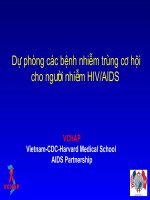SÁCH CHUYÊN NGÀNH VỀ BỆNH NHIỄM TRÙNG (Essentials of clinical INFECTION DISEASE)
Bạn đang xem bản rút gọn của tài liệu. Xem và tải ngay bản đầy đủ của tài liệu tại đây (18.44 MB, 385 trang )
Essentials of Clinical
Infectious Diseases
New York
Essentials of Clinical
Infectious Diseases
William F. Wright, DO, MPH
Assistant Professor
Division of Infectious Diseases
Department of Medicine
University of Maryland School of Medicine
Baltimore, Maryland
Acquisitions Editor: Beth Barry
Compositor: Amnet Systems Pvt. Ltd.
Visit our website at www.demosmedpub.com
ISBN: 9781936287918
e-book ISBN: 9781617051531
© 2013 Demos Medical Publishing, LLC. All rights reserved. This book is protected by copyright. No
part of it may be reproduced, stored in a retrieval system, or transmitted in any form or by any means,
electronic, mechanical, photocopying, recording, or otherwise, without the prior written permission of the
publisher.
Medicine is an ever-changing science. Research and clinical experience are continually expanding our
knowledge, in particular our understanding of proper treatment and drug therapy. The authors, editors,
and publisher have made every effort to ensure that all information in this book is in accordance with the
state of knowledge at the time of production of the book. Nevertheless, the authors, editors, and publisher
are not responsible for errors or omissions or for any consequences from application of the information in
this book and make no warranty, express or implied, with respect to the contents of the publication. Every
reader should examine carefully the package inserts accompanying each drug and should carefully check
whether the dosage schedules mentioned therein or the contraindications stated by the manufacturer
differ from the statements made in this book. Such examination is particularly important with drugs that
are either rarely used or have been newly released on the market.
Library of Congress Cataloging-in-Publication Data
Wright, William F. (William Floyd)
Essentials of clinical infectious diseases / by William F. Wright.
p. ; cm.
Includes bibliographical references and index.
ISBN 978-1-936287-91-8 (hardcover : alk. paper) ISBN 978-1-61705-153-1
(e-book)
I. Title.
[DNLM: 1. Bacterial Infections—diagnosis. 2. Bacterial Infections—drug therapy. 3. Anti-Infective
Agents—therapeutic use. 4. Communicable Diseases—diagnosis. 5. Communicable Diseases—drug
therapy. 6. Infection. WC 200]
614.597—dc23
2012042844
Special discounts on bulk quantities of Demos Medical Publishing books are available to corporations,
professional associations, pharmaceutical companies, health care organizations, and other qualifying
groups. For details, please contact:
Special Sales Department
Demos Medical Publishing, LLC
11 West 42nd Street, 15th Floor
New York, NY 10036
Phone: 800-532-8663 or 212-683-0072
Fax: 212-941-7842
E-mail:
Printed in the United States of America by Gasch Printing.
13 14 15 16 / 5 4 3 2 1
This book is dedicated to
my loving and beautiful wife, Courtney.
Contents
Contributors xi
Preface xiii
Acknowledgments xv
I. INTRODUCTION TO CLINICAL INFECTIOUS DISEASES
1. Introduction to Infectious Disease 1
William F. Wright
Bruce L. Gilliam
2. Introduction to Antimicrobial Agents 3
Emily L. Heil
Neha U. Sheth
William F. Wright
3. Introduction to Medical Microbiology 30
Nicole M. Parrish
Stefan Riedel
II. APPROACH TO FEVER AND LEUKOCYTOSIS
4. Fever of Unknown Origin 35
William F. Wright
5. Leukocytosis 44
William F. Wright
III. APPROACH TO BLOODSTREAM AND CARDIOVASCULAR
INFECTIONS
6. Endocarditis 51
Jennifer Husson
William F. Wright
7. Myocarditis 59
William F. Wright
8. Nonvalvular Intravascular Device Infections 65
William F. Wright
9. Infections Involving Intravascular Catheters 70
Eric Cox
Kerri A. Thom
IV. APPROACH TO PULMONARY INFECTIONS
10. Pneumonia 77
Ulrike K. Buchwald
Devang M. Patel
11. Empyema 89
Gonzalo Luizaga
Luciano Kapelusznik
William F. Wright
12. Lung Abscess 96
Adrian Majid
Ulrike K. Buchwald
Devang M. Patel
13. Tuberculosis 102
David W. Keckich
Ulrike K. Buchwald
V. APPROACH TO GASTROINTESTINAL INFECTIONS
14. Diverticulitis 113
William F. Wright
15. Appendicitis 119
William F. Wright
16. Pancreatic Infections 125
William F. Wright
17. Peritonitis 130
William F. Wright
18. Infectious Diarrhea 137
William F. Wright
19. Clostridium difficile Colitis 144
Ryan S. Arnold
William F. Wright
VI. APPROACH TO HEPATOBILIARY INFECTIONS
20. Cholecystitis 151
William F. Wright
21. Acute Cholangitis 156
William F. Wright
VII. APPROACH TO HEPATIC INFECTIONS
22. Hepatic Abscess 161
William F. Wright
23. Hepatitis A 167
William F. Wright
viii Contents
Contents ix
24. Hepatitis B 172
Luciano Kapelusznik
Rohit Talwani
William F. Wright
25. Hepatitis C 179
Rohit Talwani
Luciano Kapelusznik
William F. Wright
VIII. APPROACH TO RENAL-URINARY INFECTIONS
26. Urinary Tract Infections 185
Janaki C. Kuruppu
William F. Wright
27. Pyelonephritis and Renal Abscess 191
Jason Bailey
Janaki C. Kuruppu
William F. Wright
28. Catheter-Related Urinary Tract Infections 199
Clare Rock
Kerri A. Thom
William F. Wright
IX. APPROACH TO NEUROLOGICAL INFECTIONS
29. Meningitis 205
William F. Wright
30. Infectious Encephalitis 212
William F. Wright
31. Brain Abscess 218
William F. Wright
X. APPROACH TO ORTHOPEDIC-RELATED INFECTIONS
32. Osteomyelitis 225
William F. Wright
33. Septic Arthritis 233
William F. Wright
34. Prosthetic Joint Infections 241
William F. Wright
XI. APPROACH TO SKIN AND SOFT-TISSUE INFECTIONS
35. Cellulitis 251
William F. Wright
36. Necrotizing Skin and Soft-Tissue Infections 257
William F. Wright
37. Diabetic Foot Infections 261
William F. Wright
XII. APPROACH TO SEXUALLY TRANSMITTED INFECTIONS
38. Sexually Transmitted Diseases 267
Eric Cox
Leonard A. Sowah
39. HIV and AIDS 276
Shivakumar Narayanan
Guesly Delva
Robert R. Redfield
Bruce L. Gilliam
XIII. APPROACH TO INFECTIONS RELATED TO OBSTETRICS
AND GYNECOLOGY
40. Obstetrics and Gynecology-Related Infections 299
Jennifer Husson
Leonard Sowah
XIV. APPROACH TO EYE INFECTIONS
41. Infectious Keratitis 311
Jason Bailey
Anthony Amoroso
William F. Wright
42. Endophthalmitis 318
Adrian Majid
Anthony Amoroso
William F. Wright
XV. APPROACH TO SEPSIS
43. Systemic Inflammatory Response Syndrome and Sepsis 325
John Vaz
Devang M. Patel
William F. Wright
XVI. APPROACH TO TRANSPLANT-RELATED INFECTIONS
44. Hematopoietic Stem Cell Transplant Infections 335
Michael Tablang
David J. Riedel
45. Solid Organ Transplant Infections 341
Michael Tablang
Charles E. Davis
XVII. INFECTION CONTROL AND EPIDEMIOLOGY
46. Basic Approach to Infection Control and Epidemiology 349
Clare Rock
Surbhi Leekha
Index 357
x Contents
Contributors
Anthony Amoroso, MD, Assistant Professor, Division of Infectious Diseases,
Department of Medicine, University of Maryland School of Medicine
Ryan S. Arnold, MD, Fellow, Division of Infectious Diseases, Department of
Medicine, University of Maryland School of Medicine
Jason Bailey, DO, Fellow, Division of Infectious Diseases, Department of
Medicine, University of Maryland Schoolof Medicine
Ulrike K. Buchwald, MD, Assistant Professor, Division of Infectious Diseases,
Department of Medicine, University of Maryland School of Medicine
Eric Cox, MD, Fellow, Division of Infectious Diseases, Department of Medicine,
University of Maryland Schoolof Medicine
Charles E. Davis, MD, Associate Professor, Division of Infectious Diseases,
Department of Medicine, University of Maryland School of Medicine
Guesly Delva, MD, Fellow, Division of Infectious Diseases, Department of
Medicine, University of Maryland School of Medicine
Bruce L. Gilliam, MD, Director, Infectious Diseases FellowshipProgram, Associate
Professor, Division of InfectiousDiseases, Department of Medicine, University
of Maryland School of Medicine
Emily L. Heil, PharmD, BCPS, Infectious Diseases Clinical Pharmacy Specialist,
Department of Pharmacy, University of Maryland Medical Center
Jennifer Husson, MD, MPH, Fellow, Division of Infectious Diseases, Department
of Medicine, University of Maryland School of Medicine
Luciano Kapelusznik, MD, Assistant Professor, Division of Infectious Diseases,
Department of Medicine, University of Maryland School of Medicine
David W. Keckich, MD, Fellow, Division of Infectious Diseases, Department of
Medicine, University of Maryland School of Medicine
Janaki C. Kuruppu, MD, Assistant Professor, Division of Infectious Diseases,
Department of Medicine, University of Maryland School of Medicine
Surbhi Leekha, MBBS, MPH, Assistant Professor, Division of Infectious Diseases,
Department of Epidemiology and Public Health and Medicine, University of
Maryland School of Medicine, Associate Hospital Epidemiologist; University of
Maryland MedicalCenter
Gonzalo Luizaga, MD, Fellow, Division of Infectious Diseases, Department of
Medicine, University of Maryland School of Medicine
Adrian Majid, MD, Fellow, Division of Infectious Diseases, Department of
Medicine, University of Maryland School of Medicine
Shivakumar Narayanan, MBBS, Fellow, Division of Infectious Diseases,
Department of Medicine, University of Maryland School of Medicine
Nicole M. Parrish, PhD, MHS, D (ABMM), Assistant Professor, Division of
Microbiology Department of Pathology, Johns Hopkins University School of
Medicine
Devang M. Patel, MD, Assistant Professor, Division of Infectious Diseases,
Department of Medicine, University of Maryland School of Medicine
Robert R. Redfield, MD, Chair, Division of Infectious Diseases, Professor of
Medicineand, Professor of Microbiology and Immunology, University of
Maryland Schoolof Medicine
David J. Riedel, MD, Assistant Professor, Division of Infectious Diseases,
Department of Medicine, University of Maryland School of Medicine
Stefan Riedel, MD, PhD, D (ABMM), Director, Clinical Laboratories, Johns
Hopkins Bayview Medical Center, Assistant Professor, Division of Microbiology,
Department of Pathology, Johns Hopkins University School of Medicine
Clare Rock, MD, Fellow, Division of Infectious Diseases, Department of Medicine,
University of Maryland School of Medicine
Neha U. Sheth, PharmD, BCPS, AAHIVE, Assistant Professor, University of
Maryland School of Pharmacy
Leonard Sowah, MBChB, MPH, Assistant Professor, Division of Infectious
Diseases, Department of Medicine, University of Maryland School of Medicine
Michael Tablang, MD, Fellow, Division of Infectious Diseases, Department of
Medicine, University of Maryland School of Medicine
Rohit Talwani, MD, Assistant Director, Infectious Diseases Fellowship Program,
Assistant Professor, Division of Infectious Diseases, Department of Medicine,
University of Maryland School of Medicine
Kerri A. Thom, MD, MS, Assistant Professor, Division of Infectious Diseases,
Departmentof Epidemiology and Public Health and Medicine, University of
Maryland School of Medicine
John Vaz, MD, Fellow, Division of Infectious Diseases, Department of Medicine,
University of Maryland School of Medicine
William F. Wright, DO, MPH, Assistant Professor, Division of Infectious Diseases,
Department of Medicine, University of Maryland School of Medicine
xii Contributors
Preface
Essentials of Clinical Infectious Diseases was developed from our experience teach-
ing infectious diseases, microbiology, and antimicrobial pharmacology to students,
residents, fellows, and primary care physicians at the University of Maryland School
of Medicine. Our goal was to present current basic science and clinical concepts for
each major infectious disease topic in a clear and easily accessible format for read-
ers. We adhere wherever possible to a standard pattern of description that aims to
define the topic; provide an introduction including classification, pathophysiology,
and epidemiologic information; list relevant causative microorganisms; and describe
the salient clinical aspects and diagnostic and therapeutic approach (physical
examination and relevant laboratory methods, diagnostic imaging, and appropri-
ate antimicrobial therapy). We have also gone beyond the basic clinical syndromes
to cover important related topics such as antimicrobial agents, medical microbiol-
ogy, fever and neutropenia, approach to evaluating leukocytosis, infectious diseases
approach to SIRS and sepsis, and basic approach to infection control and hospital
epidemiology.
While medicine continues to evolve and the amount of knowledge a learner
must retain may seem daunting, knowing basic concepts can make the approach
to a patient with a possible infection an easy and exciting task. Although this text
is arranged by specific infectious disease topics, patients typically present with a
constellation of symptoms and signs. Knowing basic concepts, therefore, can help
clinicians arrive at the diagnosis of the disease causing the patient’s symptoms and
signs. This process of clinical problem solving begins by discussing with the patient
the chronology of events associated with the symptoms or signs experienced and
asking appropriate questions. A complete physical examination is then performed
for diagnostic clues that lead to the formulation of a differential diagnosis that is
predicated on an understanding of these basic concepts. Based on the initial dis-
cussion and examination, appropriate laboratory or imaging tests are ordered to
support or refute the diagnostic considerations. It is our hope that this practical
reference will help guide the reader through the diagnostic evaluation as well as
the process of caring for the patient with an infection.
The editor and contributing authors have collaborated to prepare chapters con-
sistent with the medical literature and their teaching, clinical, and research activities
within academic medicine. Each chapter concludes with key references to current
literature and classic articles for further study if desired. Through this Essentials text
the authors strive enthusiastically to impart to readers a solid fundamental knowl-
edge and approach to clinical infectious diseases that will sustain them adequately
in their chosen medical professional career.
William F. Wright, DO, MPH
Acknowledgments
I am very grateful to all the contributing authors for their hard work and dedication
to this book and our profession. I would also like to personally thank several addi-
tional colleagues who reviewed many sections of the manuscript and/or provided
many helpful suggestions. The book would not have been possible without the sup-
port and assistance of these additional individuals:
Neil Abramson, MD
Majdi N. Al-Hasan, MBBS
Andrea Chao Bafford, MD
Richard Colgan, MD
W. Christopher Ehmann, MD
Silvia M. Ferretti, DO
Samuel M. Galvagno Jr, DO, PhD
John D. Goldman, MD, FACP
John N. Goldman, MD
Richard N. Greenberg, MD
Luciano Kapelusznik, MD
Christine Kell, PhD
Matthew E. Lissauer, MD, FACS
Philip Mackowiak, MD
Michelle S. Rarick, RPh
Julie A. Ribes, MD, PhD
Ryan M. Scilla, MD
Christine N. Shiner, PharmD
Wendy Stock, MD
Jennifer W. Toth, MD
Michael Young, MD
John J. Zurlo, MD
1
I. Introduction to Clinical
Infectious Diseases
Introduction to Infectious Disease
William F. Wright, DO, MPH
Bruce L. Gilliam, MD
Clinical medicine and infectious diseases have dramatically changed over the past
century. The practice has evolved from a healing art in which standards were based
mainly on the personal experience of physicians to a discipline focused on the
scientific method and evidence-based practice standards. While scientific advances
serve as the evolutionary basis for the diagnostic and therapeutic approaches to
common medical and infectious-disease conditions, reconciling the traditional phys-
ical diagnostic approach with contemporary diagnostic methods has been a con-
tinuous process throughout the history of medicine and clinical infectious diseases.
The approach to the patient with an infectious disease is still best accomplished by
a systematic method that combines the critically important comprehensive history
and physical examination with the added benefits of contemporary technology. This
process, the basis of the fundamental skills of medical diagnosis and treatment,
strives to improve the physician’s clinical reasoning and includes:
1. Understanding disease definitions, mechanisms, and patterns
2. Identifying the patient’s chief complaint and performing a chronologically accu-
rate medical history
3. Formulating a differential diagnosis based on the chief complaint and medical
history (also known as the pretest probability)
4. Performing physical-examination maneuvers that will support or refute the con-
ditions being considered in the differential diagnosis
5. Ordering appropriate diagnostic and laboratory tests and interpreting the results
in relation to the differential diagnosis (also known as the posttest probability)
6. Implementing an appropriate treatment plan
The purpose of this clinical reasoning is to establish a systematic and rational
approach to medical decision making that allows the physician to explain the
patient’s symptoms based on one unified diagnosis (ie, Occam’s razor).
Critically important when applying this process to clinical infectious diseases are
the chief complaint and an extended medical history that ideally includes antibiotic
uses and allergies, past medical conditions and/or infections, sexual practices, drug
use, travel destinations, occupational history, screening tests (eg, purified protein
derivative, or PPD), and vaccinations, which when taken together, provide important
clues to the risk of acquiring an infection. However, one of the more difficult pro-
cesses in clinical infectious diseases is the synthesis of all data including organisms
identified in the microbiology laboratory to distinguish between an infectious process
2 I. Introduction to Clinical Infectious Diseases
and colonization. Colonization is generally considered to be the presence of a par-
ticular microorganism or group of microorganisms (ie, normal flora) in which their
presence does not create a specific host immune response (ie, infection). In contrast,
infection is most commonly due to the invasion of body tissues with a particular
microorganism or group of microorganisms that elicits an immune response that
results in a disease state.
This book is designed to assist physicians of any specialty and at all levels—
students, residents, and attending—with the diagnosis and management of clinical
infectious diseases. Within the book, we emphasize the core topics encountered by
most physicians and highlight the definitions, classifications, microorganisms, clini-
cal manifestations, physical examination clues, contemporary diagnostic and labora-
tory methods, and treatment. A physician who utilizes the process outlined above
will ask the appropriate questions, elicit the pertinent symptoms and signs, order
the appropriate diagnostic tests, and follow clinical reasoning to a definitive diagno-
sis. In the end, this will result in optimal outcomes for patients and physicians alike.
2
Introduction to Antimicrobial Agents
Emily L. Heil, PharmD, BCPS
Neha U. Sheth, PharmD, BCPS, AAHIVP
William F. Wright, DO, MPH
I. IntroductIon. Understanding of the general factors involved with deter-
mining appropriate antimicrobial therapy for patients with an infection is an
important aspect of practicing clinical infectious diseases. While the preferred
antimicrobial agents for the treatment of specific infections are discussed in the
respective chapters, the following principles should provide guidance to the
appropriate selection and use of these agents:
A. Appropriate microbiological cultures should be obtained prior to starting
antimicrobial therapy. An exception to this rule is that empirical antibiotic
therapy should be initiated immediately in critically ill, unstable patients
when an infection is suspected.
B. Accurate microbiological identification and antimicrobial susceptibility
testing should be performed for the appropriate selection of antimicrobial
therapy. In general, especially for severe infections, the agent should be bac-
tericidal to the pathogen.
c. Appropriate selection and dosing of the antimicrobial agent should always
consider patient age, weight, medication allergy history, and co-morbid con-
ditions (eg, immunosuppression or pregnancy) as well as both hepatic and
renal function. In general, antimicrobial agents should be well tolerated and
cost effective.
II. AntIBActerIAl AntImIcroBIAls. (See Table 2.1.)
A. Aminoglycosides (gentamicin, tobramycin, and amikacin).
1. Activity. These are a group of bactericidal drugs with concentration-
dependent killing, a post-antibiotic effect, and can be synergistic
with certain antibiotics. Most widely used for gram-negative enteric
bacteria, Pseudomonas spp, and certain gram-positive bacteria (eg,
Staphylococcus aureus and Enterococcus spp). Aminoglycosides inhibit
protein synthesis by irreversibly binding to the 30S bacterial ribosome.
2. Resistance. Resistance to aminoglycosides can occur via enzymatic inac-
tivation (plasmid mediated), decreased drug uptake, and ribosomal muta-
tion (chromosomal).
3. Toxicity (pregnancy class D). Therapeutic drug monitoring of amino-
glycoside levels should be done to avoid nephrotoxicity (renal tubular
damage) and ototoxicity and to ensure efficacy.
(text continues on p. 14)
4
tABle 2.1 ■ Antibacterial agents
Target Class Agents Spectrum Adverse Effects Pharmacology
Bacterial
cell wall
Penicillins Natural
penicillins
Penicillin G
(IV)
Penicillin V
(PO)
Good: Streptococci,
Treponema pallidum
Moderate: Enterococcus,
Streptococcus
pneumoniae
Hypersensitivity
reactions
Acute interstitial
nephritis
GI
Very short half-life
Hepatic metabolism
accounts for ,30%,
excreted via glomeru-
lar and tubular
secretion
Penicillinase-
resistant
penicillins
Oxacillin (IV)
Nafcillin (IV)
Dicloxicillin
(PO)
Methicillin (IV)
Good: Staphylococcus
aureus, Streptococci
Hypersensitivity
reactions
GI
Rare hepatotoxicity
Acute interstitial
nephritis
Highly protein bound.
Hepatic metabolism
accounts for ~50% of
dose. Primarily
excreted by the liver
and to a lesser extent
the kidneys
Aminopenicillin Ampicillin
(PO, IV)
Amoxicillin
(PO)
Good: Streptococci,
Enterococci
Moderate: enteric
gram-negative rods,
Haemophilus
Poor: Staphylococci,
anaerobes
Hypersensitivity
reactions
GI
Rare hematological
effects
Absorbed well from the
GI tract; widely
distributed in tissues
(especially inflamed
tissue); renal excretion
Antipseudomonal
penicillins
Piperacillin (IV) Good: Pseudomonas,
Streptococci, Enterococci
Moderate: enteric
gram-negative rods,
Haemophilus
Poor: Staphylococcus,
anaerobes
Similar to other
beta-lactams
5
tABle 2.1 ■ (Continued)
(Continued)
Target Class Agents Spectrum Adverse Effects Pharmacology
Beta-lactam/
beta-lactamase
inhibitor
combinations
Ampicillin/
sulbactam (IV)
Amoxicillin/
clavulanic acid
(PO)
Ticarcillin/
clavulanic
acid (IV)
Piperacillin/
tazobactam (IV)
Good: Staphylococcus
aureus, Streptococci,
Enterococci, enteric
gram-negative rods,
anaerobes, Pseudomonas
(only piperacillin/
tazobactam and
ticarcillin/clavulanic acid)
Poor: atypicals, extended-
spectrum beta-lactamase-
producing gram-negatives
Hypersensitivity
reactions
Acute interstitial
nephritis
GI (diarrhea, especially
with amoxicillin/
clauvlanic acid)
Hematologic effects
(thrombocytopenia
with piperacillin/
tazobactam)
CNS toxicity (seizures)
with high doses
Renal excretion
beta-lactamase inhibitor
component does not
cross the blood brain
barrier
Cephalosporins First generation Cefazolin (IV)
Cephalexin (PO)
Good: Staphylococcus
aureus
Moderate: enteric
gram-negative rods
Poor: Enterococci,
anaerobes, Pseudomonas
GI Highly protein bound,
poor CNS penetration
Primarily excreted
unchanged in the
urine
Second
generation
Cefuroxime
(IV and PO)
Cefprozil (PO)
Cefoxitin (IV)
Cefotetan (IV)
Good: some enteric
gram-negative rods,
Haemophilus, Neisseria
Moderate: Streptococci,
Staphylococci
Poor: Enterococci,
Pseudomonas, anaerobes
(cefoxitin and cefotetan
have added gram-
negative anaerobe
coverage)
GI
Cefoxitin/cefotetan
interfere with
vitamin K–dependent
coagulation; may
increase PT/INR
Primarily renal excretion
6
Target Class Agents Spectrum Adverse Effects Pharmacology
Bacterial
cell wall
(cont.)
Third
generation
Cefotaxime (IV)
Ceftriaxone (IV)
Cefpodoxime
(PO)
Cefixime (PO)
Ceftazidime (IV)
Good: Streptococci,
Staphylococcus
aureus, enteric gram-
negative rods,
Pseudomonas
(ceftazidime only)
Poor: Enterococci,
anaerobes
Ceftriaxone can
cause cholestatis/
biliary sludging
Cefpodoxime interferes
with vitamin K
production; may
increase PT/INR
Cefotaxime and
ceftriaxone have the
best CSF penetration
Renal excretion with the
exception of ceftriax-
one (biliary excretion)
Fourth
generation
Cefepime (IV) Good: Staphylococcus
aureus, Streptococci,
Pseudomonas, enteric
gram-negative rods
Poor: Enterococci,
anaerobes
Rare convulsions (high
doses in renal failure)
Positive Coombs test
(without hemolytic
anemia)
20% protein bound,
decent CSF
concentrations
85% excretion
unchanged in the
urine
Anti-MRSA Ceftaroline (IV) Good: Staphylococcus
aureus (including
methicillin-resistant),
enteric gram-negative
rods
Poor: Enterococci,
anaerobes, Pseudomonas
GI Ceftaroline fosamil is
dephosphorylated to
ceftaroline—ceftaro-
line and metabolite
renally excreted.
Carbapenems Imipenem/
cilastatin (IV)
Meropenem (IV)
Doripenem (IV)
Ertapenem (IV)
Good: Staphylococcus
aureus, Streptococci,
anaerobes, enteric
gram-negative rods,
extended-spectrum
beta-lactamase-producing
gram-negative rods,
Pseudomonas
(EXCEPT ertapenem)
Moderate: Enterococcus
Lower seizure
threshold
(associated with
higher doses, or
normal doses in
patients with renal
impairment,
imipenem to the
greatest extent)
Well distributed into
body tissues; variable
CSF penetration
Eliminated primarily
unchanged in the
urine
tABle 2.1 ■ (Continued)
7
Target Class Agents Spectrum Adverse Effects Pharmacology
Monobactams Aztreonam (IV) Good: Pseudomonas, most
gram-negative rods
Poor: gram-positive
organisms, anaerobes
Similar to other
beta-lactams
Renally excreted
Glycopeptides Vancomycin
(IV, PO)
Good: Staphylococcus
aureus (including
methicillin-resistant),
Streptococci, Clostridium
difficile (PO only)
Moderate: Enterococci
Poor: gram-negatives
Red man syndrome
(infusion-related
histamine release)
Thrombophlebitis
Nephrotoxicity
(interstitial nephritis)
and ototoxicity
Poorly absorbed in the GI
tract, penetrates well
into most areas of the
body except CNS
(without meningeal
inflammation)
90% excreted by glomeru-
lar filtration
Lipopeptides Daptomycin (IV) Good: Staphylococcus
aureus (including
methicillin-resistant),
Streptococci, Enterococci
(including vancomycin-
resistant)
Poor: gram-negatives
Rare rhabdomyolisis Long half-life
Highly protein
bound—poor CSF
penetration
Inactivated by
pulmonary surfactant
Primarily renal
excretion
Polymyxin Polymixin B
Colistimethate
Good: Acinetobacter,
Pseudomonas, Klebsiella
pneumoniae, Escherichia
coli
Poor: Proteus, Providencia,
Burkholderia, Serratia,
gram-positives
Nephrotoxicity (acute
tubular necrosis)
Neurotoxicity
Enhancement of
neuromuscular
blockade
Widely distributed
into body tissues, low
levels in synovial,
pleural and pericardial
fluid. ~25% CNS
penetration with
meningeal
inflammation
Renal excretion
(Continued)
tABle 2.1 ■ (Continued)
8
Target Class Agents Spectrum Adverse Effects Pharmacology
Protein
synthesis
Aminoglycosides Amikacin (IV)
Gentamicin (IV)
Tobramycin (IV)
Good: gram-negatives,
including Pseudomonas
and Acinetobacter
Moderate: Staphy lococci,
Streptococci, Enterococci
(for these gram-positives
must be combined
with a beta-lactam or
glycopeptide)
Poor: anaerobes, atypicals
Nephrotoxicity
Ototoxicity
Enhanced
neuromuscular
blockade
Not absorbed from the
GI tract
Poor penetration into
lungs and CSF
Volume of distribution
correlates with volume
of extracellular fluid
(dose based on adjusted
or ideal body weight)
Excreted unchanged via
glomerular filtration
Macrolides Clarithromycin
(PO),
azithromycin
(PO, IV),
erythromycin
(IV, PO)
Good: atypicals,
Haemophilus influen-
zae, Moraxella catar-
rhalis, Helicobacter
pylori, Mycobacterium
avium
Moderate: Streptococcus
pneumoniae, S pyogenes
Poor: Staphylococci, enteric
gram-negative rods,
(azithromycin .
clarithromycin),
anaerobes, Enterococci
GI: nausea, vomiting,
diarrhea
(erythromycin is the
worst)
Hepatic: telithromycin
most severe
Cardiac: QT prolonga-
tion (most with
erythromycin)
Well absorbed (food
reduced absorption of
erythromycin);
penetrates well into
tissues
Excreted in bile
tABle 2.1 ■ (Continued)









